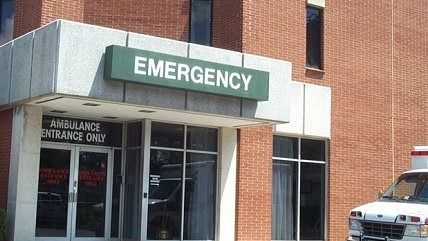How Much Charity Care Do Hospitals Really Provide?
If the public is being asked to pay more for charity care, and it is, then it's reasonable to ask exactly what it's getting for its money.

How much charity care do hospitals really provide? Nobody may know for sure. Hospitals report figures, but the numbers are squishy, and nobody checks them anyway.
That's a big deal because some hospitals get heaping sums of taxpayer money to compensate them, partially, for the charity care they provide. What's more, hospitals use charity care as an argument for expanding Medicaid. "We see a significant amount of indigent patients at our hospitals in Northern Virginia," said a lobbyist for Inova last February. "A significant percentage of them would be eligible for Medicaid insurance under the expansion of Medicaid." In a December statement, the Virginia Hospital & Healthcare Association praised the "tireless efforts" of Gov Terry McAuliffe (D) to expand Medicaid, noting the "over $600 million per year in indigent care" its members provide.
In a Daily Press article last year, hospital executives warned that "beds could close, nurses could lose jobs and it could be tougher for Hampton Roads families to find a place to have babies or get mental health care unless Virginia finds some way to pay for the hundreds of millions of dollars a year hospitals give the area's poor and disabled."
Some of those cuts affect so-called DSH payments, which amounted to more than $163 million in fiscal 2015. The money goes to hospitals that provide a "disproportionate share" of medical care to indigent patients. Health-care reform will shrink DSH payments (PDF) by hundreds of millions of dollars in the coming decades. Hospitals are not happy.
And they have every right not to be. Federal law, the Emergency Medical Treatment & Labor Act (EMTALA), forbids hospitals to turn patients away from the emergency room. Most wouldn't do so anyway, but the combination of EMTALA and shrinking payments for uncompensated care means the government is forcing hospitals to provide a public benefit and internalize the cost. That's not too different from outright conscription.
Virginia also imposes an outdated and unjustifiable regulatory regime called Certificate of Public Need. It requires health-care providers to get the state's permission before building a hospital, or adding a wing, or even purchasing expensive equipment such as MRI machines. As a condition of approving new investments through COPN, Virginia sometimes demands that providers perform a certain level of charity care in return.
Still, in some cases the complaints about shrinking charity-care payments could be overwrought. While many rural hospitals are on shaky fiscal ground, the same does not hold true for the industry as a whole. VCU Health, for instance, was in the black to the tune of almost $200 million a couple of years ago. Henrico Doctors' cleared almost $50 million. Even hospitals in nonprofit systems, like Bon Secours St. Mary's, came out ahead by $65 million. The margins might have shrunk since those figures were reported - but by how much?
The more interesting "how much" question is how much hospitals actually spend on charity care. A 2011 state report (PDF) notes that there is no common standard for charity-care reporting, and this "limits the extent to which hospital-sponsored charity care can be measured." What's more, the hospitals report the figures themselves—and nobody is checking behind them. "We take their word for it," says Peter Boswell, who oversees hospital licensing in Virginia.
A spokesman for Bon Secours says its numbers reflect "charges reduced to the true out-of-pocket costs to provide the care." So if it costs Bon Secours $500 to set an indigent patient's broken bone, then Bon Secours reports $500 in charity care for that patient. But not everybody does it that way. Some report charity care in terms of "gross revenue forgone." In other words, it might cost $500 to set a broken bone—but if a hospital could have billed $10,000 for the service, then it will claim to have provided $10,000 in charity care rather than $500.
This leaves at least some claims about charity care suspect, since—as noted in last week's column—hospital prices are extremely volatile. Different hospitals charge different prices for the same good or service. What's more, individual hospitals charge different patients vastly different prices for the same good or service as well. Since prices are so arbitrary, and usually inscrutable, that leaves no way to check a hospital's math. Policing claims about charity care is difficult, says the Department of Medical Assistance Services' William Lessard, because "hospitals have very widely different cost-to-charge ratios."
Virginia Secretary of Health and Human Resources William Hazel puts it more bluntly. "We have no ability to double-check it, audit it, or whatever," he says. How hospitals arrive at charity-care figures is, he says, "mystical to me."
Which leads to a final question: Does it matter? After all, hospitals do provide an immense amount of charity care. If they didn't, a lot of people would suffer horribly, and many would die. Maybe it's churlish and ungrateful to quibble over the precise dollar amount.
Then again, the lack of a common standard could leave some institutions at a disadvantage. If Hospital A bases its figures on its actual costs, while Hospital B bases its figures on revenue foregone, then Hospital A could be getting short-changed while Hospital B could be getting credit, and public money, for doing more than it really is.
There's this, too: If the public is being asked to pay more for charity care, and it is, then it's reasonable to ask exactly what it's getting for its money.
Correction: Last week I wrote that two-thirds of states declined to expand Medicaid. That figure is out of date; 31 states and the District have expanded Medicaid or adopted a similar alternative.
This article originally appeared at the Richmond Times-Dispatch.


Show Comments (29)